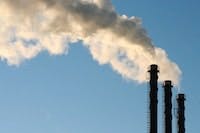The World Bank is launching a new initiative at the World Future Energy Summit and International Water Summit in Abu Dhabi that will help developing countries better plan and manage scaling-up energy capacity to meet rising demand, in tandem with water resource management.
Producing energy requires a lot of water, yet the availability of and access to water is negatively impacting energy production around the world.
Last year alone, water shortages shut down thermal power plants in India, decreased energy production in power plants in the U.S. and threatened hydropower generation in many countries, including Sri Lanka, China and Brazil.
The problem is expected only to get worse. By 2035, the world's energy consumption will increase by 35%, which will increase water consumption by 85%, according to the International Energy Agency.
"The world's energy and water are inextricably linked. With demand rising for both resources and increasing challenges from climate change, water scarcity can threaten the long-term viability of energy projects and hinder development," said Rachel Kyte, World Bank Group vice president and special envoy for climate change.
Part of the challenge for the energy sector is the competing demand for water. This demand will grow as the world's population reaches 9 billion, requiring a 50% increase in agricultural production and a 15% increase in already-strained water withdrawals. With two-thirds of the world's population—or 5 billion people—urbanized by 2030, cities in developing countries will be under tremendous pressure to meet the demand for food, energy and water services. Yet today, some 780 million people lack access to improved water and 2.5 billion, more than one-third of the world's people, do not have basic sanitation.
Thirsty Energy is a global initiative aimed to help governments prepare for an uncertain future by:
- • identifying synergies and quantifying tradeoffs between energy development plans and water use;
- • piloting cross-sectoral planning to ensure sustainability of energy and water investments; and
- • designing assessment tools and management frameworks to help governments coordinate decision-making.
With the energy sector as an entry point, initial work has already started in South Africa and dialogue has been initiated in Bangladesh, Morocco and Brazil where the challenges have already manifested and thus where demand exists for integrated approaches.
Failing to anticipate water constraints in energy investments can increase risks and costs for energy projects. In fact, the majority of energy and utility companies consider water a substantive risk and report water-related business impacts.
"Water constraints on the energy sector can be overcome, but all stakeholders, public and private, must work together to develop innovative tools and use water as a guiding factor for assessing viability of projects," said Maria van der Hoeven, executive director of the International Energy Agency. "The absence of integrated planning is unsustainable."
Solutions exist, but countries must continue to innovate and adapt policies and technology to address the complexity of the landscape. These solutions include technological development and adoption, improved operations to reduce water use and impacts in water quality, and strong integrated planning.
"We cannot meet our global energy goals of extending access to the poor, increasing efficiency and expanding renewables without water. The water energy interrelationship is critical to build resilient as well as efficient, clean energy systems. The time to act is now," Kyte said.
Source: World Future Energy Summit


